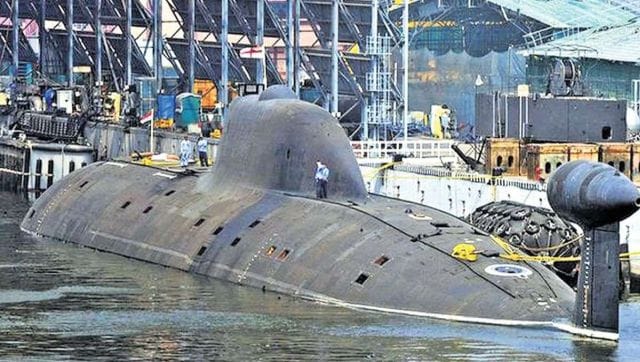India’s naval prowess will receive a huge boost today (August 29) as Defence Minister Rajnath Singh will commission the country’s second nuclear-powered ballistic missile submarine (SSBN), INS Arighat or S-3 at an event in Visakhapatnam.
Naval Staff Admiral Dinesh Tripathi, head of Indian strategic command Vice Admiral Suraj Berry and top DRDO officials are expected to be present at the event.
With the commissioning of INS Arighat, India will have two operational SSBNs; the country already has
INS Arihant in its arsenal, which was commissioned in August 2016.
As we gear up for this milestone, let’s take a closer look at the INS Arighat’s specifications and why it will be a game-changer for the Indian Navy.
All about INS Arighat
The new submarine has been named after the ancient Sanskrit term “Arighat,” meaning ‘destroyer of enemies.’ This submarine epitomises India’s commitment to safeguarding its maritime interests with unmatched deterrence.
It is the second submarine of the Arihant-class, succeeding its predecessor INS Arihant. According to a Moneycontrol report, the submarine has been under construction since its launch in 2017 at the Ship Building Centre (SBC) in Visakhapatnam.
The INS Arighat is powered by 83 MW pressurised light-water reactors and can stay submerged for months on end, giving it an edge over conventional submarines. The submarine has a displacement of 6,000 tonnes and is 112 metres long. The INS Arighat can reach a maximum speed of 12–15 knots (22–28 km/h) on the surface and up to 24 knots (44 km/h) when submerged.
Arighat also features a double hull, encompassing ballast tanks, two standby auxiliary engines, and a retractable thruster for emergency power and mobility.
The INS Arighat, like the INS Arihant, will also carry up to four nuclear-capable -4 SLBMs (Submarine Launched Ballistic Missiles) with a range exceeding 3,500 kilometres, or 12 K-15 SLBMs with a range of around 750 kilometres. Notably, the K-15 missiles can be fitted with a strategic nuclear warhead. Additionally, INS Arighat will also be armed with torpedoes.
As one source told the Times of India, “While INS Arighat is of the same size, length and displacement as INS Arihant, she can carry more K-15 missiles. The new boat is much more capable, efficient and stealthy.”
Many experts note that what makes INS Arighat a game-changer is its stealth capabilities. Equipped with advanced sonar systems, quiet propulsion, and state-of-the-art stealth technology, INS Arighat can operate undetected, lurking beneath the ocean’s surface, ready to respond to any threat swiftly and decisively. This stealthy demeanor not only enhances its survivability but also ensures that it can carry out its missions with precision and secrecy, a vital aspect of modern naval operations.
India’s submarine plan
INS Arighat is part of India’s Arihant submarine plan, being developed and built at a cost of Rs 900 billion ($12 billion).
In addition to INS Arihant and INS Arighat, India is planning on two other SSBNs, with a larger size — having 7,000 tonnes displacement. Sources told Hindustan Times that the third, INS Aridaman or S4, is also set to be commissioned next year, followed shortly after by a fourth SSBN codenamed S-4*.
According to a report in The Print, the two larger vessels will have eight missile tubes instead of four.
Notably, with the development of the Arihant-class submarines, India is part of a small group of countries that have nuclear-powered submarines. As of now, only six countries — the United States, Russia, the United Kingdom, France, China and India — are a part of this elite club. Moreover, India is also one of the few countries that has completed its nuclear triad — it has the capability to launch a nuclear weapon from land, air and underwater. The only other countries capable of this are the US, Russia, China and France.
Boost to India’s naval power
With the commissioning of INS Arighat, India will have two nuclear-powered submarines in the
Indo-Pacific region. Experts note that INS Arighat will offer huge strategic leverage and act as a deterrent to any navy trying to flex its muscles in the region.
This is crucial as China is seeking to expand its footprint in the region by setting up military bases, bullying countries to advance its unlawful maritime claims, and ensnaring vulnerable states in unsustainable debts to force strategic concessions.
The INS Arighat also serves beyond its deterrent role. It possesses the capability to conduct a wide range of missions, from anti-submarine warfare to intelligence gathering and special operations. This operational flexibility enhances India’s maritime domain awareness and its ability to respond swiftly to emerging threats, thereby contributing to regional stability and security.
As the adage goes, “He who controls the sea controls the destiny of nations.” And with INS Arighat, India hopes to be a silent sentinel over the ocean, ensuring peace, security, and prosperity for generations to come.
With inputs from agencies
Link to article –

